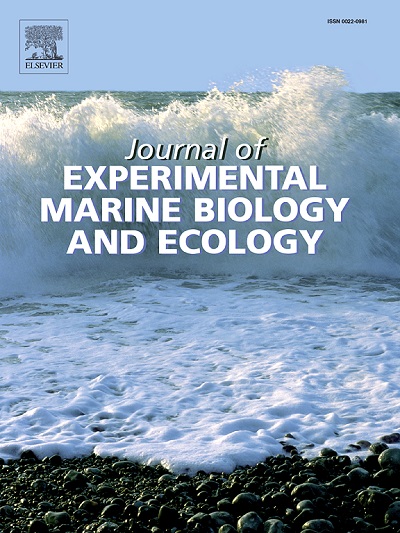暴露于模拟频繁洪水的淡水脉冲持续时间梯度中,揭示了关键底栖软体动物组合中特定物种的脆弱性阈值
IF 1.8
3区 生物学
Q3 ECOLOGY
Journal of Experimental Marine Biology and Ecology
Pub Date : 2025-07-10
DOI:10.1016/j.jembe.2025.152120
引用次数: 0
摘要
河口群落提供许多生态系统服务,极易受到全球变化的影响。土地利用的有害变化和强降雨事件增加了洪水的频率和强度,造成河口条件的突然变化。因此,海洋生物在洪水过后的几天里更经常暴露在淡水环境中。虽然河口生物能够在波动的盐度下茁壮成长,但它们对强烈和长期低渗压力的反应可能不同。了解这些反应是至关重要的,因为盐度变化是物种分布的关键。在高纬度环境中,水文制度的变化发生得快得多,但对亚北极河口群落的研究却很少。本研究调查了生活在亚北极河口的三种主要海洋底栖大型无脊椎动物(咸水滨生动物、黑藻和贻贝)对不同时间淡水暴露的敏感性。在实验室条件下,软体动物在6周内暴露于12个淡水脉冲持续时间的梯度中,范围从0到9天,穿插于24小时的海水暴露中。采用线性混合模型和断点分析,比较了2周、4周和6周暴露后贻贝的死亡率和壳生长以及能量含量。所有三个物种都表现出对几周内重复的短时间淡水脉冲(少于2天)的耐受性。沙雀的易损性最高,2周后淡水脉冲时间超过2 d,其死亡率上升。Macoma balthica显示出类似的阈值,但仅在四周后。贻贝(Mytilus spp.)表现出最大的耐耐性,只有在暴露6周后才能检测到阈值,并且在淡水脉冲超过5 d的处理中,死亡率增加。此外,只有L. saxatilis的壳生长随着淡水脉冲持续时间的增加而下降,而M. balthica和Mytilus spp的壳生长不受影响。在较长的淡水暴露期中检测到最高的能量含量,表明对低渗应激的复杂生理反应。总之,我们的研究表明,生活在亚北极河口的海洋底栖大型无脊椎动物在淡水脆弱性方面存在高度的物种特异性差异。我们的研究结果强调了利用压力情景梯度来确定生态相关阈值的重要性,有助于预测和管理极端气候事件,如河口社区的河流洪水。本研究为河口生态系统的大坝管理和生物多样性保护提供了有价值的建议。本文章由计算机程序翻译,如有差异,请以英文原文为准。

Exposure to a gradient of freshwater pulses duration mimicking frequent floodings reveals species-specific vulnerability thresholds in an assemblage of key benthic molluscs
Estuarine communities provide many ecosystem services and are highly vulnerable to global changes. Detrimental changes in land use and intense rainfall events increase the frequency and intensity of flooding, causing abrupt changes in estuarine conditions. As a result, marine organisms are more often exposed to freshwater conditions for several days after flooding. While estuarine organisms are able to thrive under fluctuating salinities, their responses to intense and prolonged hypoosmotic stress may differ. Understanding these responses is crucial as salinity variability is key to species distribution. Changes in hydrological regimes are occurring much faster in high latitudes environments, yet subarctic estuarian communities are rarely studied. Our study investigates the sensitivity of three key marine benthic macroinvertebrates inhabiting subarctic estuaries (Littorina saxatilis, Macoma balthica and Mytilus spp.) to different durations of freshwater exposure. In laboratory conditions, molluscs were exposed during six weeks to a gradient of 12 freshwater pulse durations, ranging from 0 to 9 d, interspersed with 24 h of exposure to sea water. Mortality and shell growth, as well as energy content for Mytilus spp., were compared after two, four and six weeks of exposure using linear mixed models and break-point analyses. All three species demonstrated tolerance to short-duration freshwater pulses (less than 2 d) repeated over several weeks. Littorina saxatilis exhibited the highest vulnerability, with mortality increasing under freshwater pulses longer than 2 d after two weeks. Macoma balthica displayed a comparable threshold but only after four weeks. Mytilus spp. displayed the greatest tolerance, with a threshold only detectable after six weeks of exposure and increasing mortality in treatments with freshwater pulses longer than 5 d. In addition, shell growth decreased with increasing duration of freshwater pulse only in L. saxatilis while it was not affected in M. balthica and Mytilus spp. Energy content in Mytilus spp. varied according to pulse duration and time, with the highest energy content being detected in the longer freshwater exposure periods, suggesting complex physiological responses to hypoosmotic stress. Altogether, our study indicates the existence of highly species-specific differences in freshwater vulnerability among marine benthic macroinvertebrates inhabiting subarctic estuaries. Our findings highlight the importance of using gradients of stress scenarios to identify ecologically relevant thresholds, helping in the prediction and management of extreme climate events like river floods on estuarine communities. Our study provides valuable recommendations for dam management and biodiversity conservation in estuarine ecosystems.
求助全文
通过发布文献求助,成功后即可免费获取论文全文。
去求助
来源期刊
CiteScore
4.30
自引率
0.00%
发文量
98
审稿时长
14 weeks
期刊介绍:
The Journal of Experimental Marine Biology and Ecology provides a forum for experimental ecological research on marine organisms in relation to their environment. Topic areas include studies that focus on biochemistry, physiology, behavior, genetics, and ecological theory. The main emphasis of the Journal lies in hypothesis driven experimental work, both from the laboratory and the field. Natural experiments or descriptive studies that elucidate fundamental ecological processes are welcome. Submissions should have a broad ecological framework beyond the specific study organism or geographic region.
Short communications that highlight emerging issues and exciting discoveries within five printed pages will receive a rapid turnaround. Papers describing important new analytical, computational, experimental and theoretical techniques and methods are encouraged and will be highlighted as Methodological Advances. We welcome proposals for Review Papers synthesizing a specific field within marine ecology. Finally, the journal aims to publish Special Issues at regular intervals synthesizing a particular field of marine science. All printed papers undergo a peer review process before being accepted and will receive a first decision within three months.

 求助内容:
求助内容: 应助结果提醒方式:
应助结果提醒方式:


